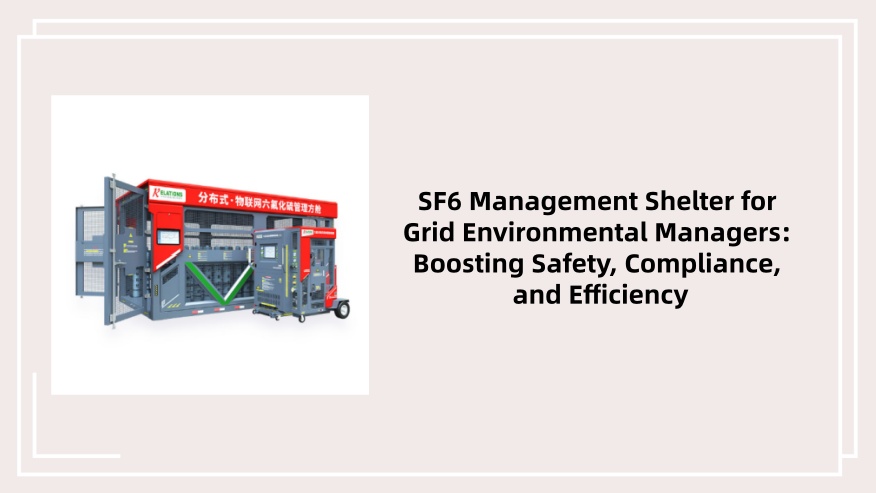
- SF6 Relations
- 2025-09-17
SF6 (sulfur hexafluoride) is a critical insulation and arc-quenching gas in high-voltage grid equipment, but it is also one of the most potent greenhouse gases—with a global warming potential (GWP) 23,500 times that of CO₂ over a 100-year period. For grid environmental managers, balancing SF6’s operational importance with strict environmental regulations and safety standards is a constant challenge. This is where a specialized SF6 Management Shelter for Grid Environmental Managers becomes an indispensable tool, addressing leakage risks, simplifying compliance, and protecting both personnel and the planet.
1. Why Grid Environmental Managers Need Specialized SF6 Management Shelters
Grid facilities rely on SF6 for transformers, circuit breakers, and gas-insulated switchgear (GIS), but improper storage, handling, or maintenance of SF6-containing equipment often leads to unintended leaks. These leaks not only contribute to climate change but also expose workers to health hazards—SF6 can displace oxygen in confined spaces, causing asphyxiation, and its decomposition products (like sulfur oxides) are toxic.
For environmental managers, regulatory pressure adds another layer of complexity. Global bodies like the EPA (U.S. Environmental Protection Agency) and IEC (International Electrotechnical Commission) mandate strict SF6 emission limits, leak detection protocols, and detailed reporting. Without a dedicated management system, tracking SF6 inventory, conducting frequent leak tests, and documenting compliance becomes time-consuming and error-prone. A purpose-built SF6 Management Shelter solves these pain points by centralizing SF6 handling and integrating tools to meet both safety and regulatory demands.
2. Key Features of SF6 Management Shelters for Grid Operations
A high-quality SF6 Management Shelter is designed with the unique needs of grid environmental managers in mind, featuring:
- Sealed, Leak-Proof Enclosures: The shelter’s airtight structure prevents SF6 leaks into the surrounding environment. It is constructed with corrosion-resistant materials (e.g., stainless steel) to withstand outdoor grid site conditions and includes pressure monitoring to alert managers of potential seal failures.
- Integrated Leak Detection & Monitoring: Built-in SF6 concentration sensors continuously track gas levels, triggering real-time alarms if leaks exceed safe thresholds (per IEC 60480 standards). Data from these sensors is logged automatically, simplifying compliance reporting.
- Safety Systems: Ventilation systems purge accumulated SF6 to maintain oxygen levels, while emergency shutoffs and personal protective equipment (PPE) storage ensure worker safety during equipment maintenance or leak responses.
- Space Optimization: Shelters are sized to accommodate SF6 storage cylinders, maintenance tools, and even small GIS components, keeping all SF6-related operations centralized and organized—reducing the risk of accidental spills or mismanagement.
3. Benefits for Grid Environmental Managers: Beyond Basic Storage
For grid environmental managers, the value of an SF6 Management Shelter extends far beyond secure storage:
- Simplified Compliance: Automated data logging (e.g., leak test results, SF6 inventory levels) eliminates manual record-keeping, making it easy to meet EPA’s Greenhouse Gas Reporting Program (GHGRP) or EU Emissions Trading System (ETS) requirements. Managers can generate compliance reports in minutes, not hours.
- Reduced Environmental Impact: By preventing leaks, shelters directly cut SF6 emissions, helping grid operators meet corporate sustainability goals and national carbon reduction targets. For example, a single shelter can reduce annual SF6 leaks by 50% or more, based on industry case studies.
- Lower Operational Costs: Leaks waste expensive SF6, and non-compliance leads to costly fines. A shelter minimizes gas loss and avoids penalties, while its durable design reduces long-term maintenance costs compared to ad-hoc storage solutions.
- Enhanced Worker Safety: By confining SF6 to a controlled space and providing real-time alerts, shelters eliminate the risk of accidental exposure—protecting teams and reducing liability for grid operators.
4. Best Practices for Implementing SF6 Management Shelters
To maximize the value of an SF6 Management Shelter, grid environmental managers should:
- Align with Regulations: Choose a shelter certified to meet local and international standards (e.g., EPA 40 CFR Part 98, IEC 61634). This ensures the shelter supports compliance from day one.
- Integrate with Existing Systems: Connect the shelter’s monitoring tools to the grid’s central environmental management software. This allows for real-time data sharing and streamlined oversight of SF6 across multiple sites.
- Train Teams: Ensure staff are trained to use the shelter’s safety features, conduct leak tests, and interpret monitoring data. Regular training reduces human error and keeps safety protocols top of mind.
- Perform Routine Maintenance: Schedule quarterly inspections of the shelter’s seals, sensors, and ventilation systems. Proactive maintenance prevents unexpected failures and extends the shelter’s lifespan.
For grid environmental managers tasked with balancing SF6’s operational role and environmental responsibility, a specialized SF6 Management Shelter is more than a storage solution—it is a strategic asset. By preventing leaks, simplifying compliance, and protecting workers, shelters help grid operators meet sustainability goals, avoid fines, and ensure reliable operations. As regulations grow stricter and climate action becomes a priority, investing in a high-quality SF6 Management Shelter will remain a critical step for forward-thinking grid organizations.
Leave a Reply